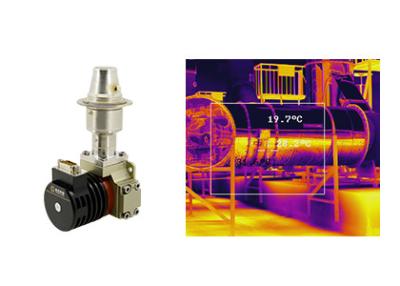







| Price | Negotiable |
| MOQ | 1 Piece |
| Delivery Time | Negotiable |
| Brand | GST |
| Place of Origin | Wuhan, Hubei Province, China |
| Certification | ISO9001:2015; RoHS; Reach |
| Model Number | C330M-G |
| Payment Terms | L/C, T/T |
| Place of Origin | Wuhan, Hubei Province, China | NETD | ≤15mK |
| Spectral Range | 3.2±0.1~3.5±0.1μm | Detector Resolution | 320x256 |
| Cryo Cooler | RS058/RS058I/LS734 | Pixel Size | 30μm |
| Model Number | C330M-G | Certification | ISO9001:2015; RoHS; Reach |
| Brand Name | GST | Payment Terms | L/C, T/T |
| Function | Gas Leak Detection | Price | Negotiable |
| Minimum Order Quantity | 1 Piece |
VOCs Gas Leak Detection Cooled MWIR Thermal Imaging Detector 320x256 30μM
C330M-G cooled infrared detector is specially developed for VOCs gas leak detection with the function of converting infrared radiation of target with 3.2~3.5μm wavelength into electrical signal. Its external mechanical interface, optical interface and electronic interface are commonly used and can be expanded. C330M-G can be widely used in atmospheric environment monitoring and gas leakage detection, pollutant discharge, chemical gas detection in petrochemical plants and refineries.
Optical
Gas
Imaging
•
Long
range
non-contact
detection
•
High
efficient,
secure
and
wide
range
of
gas
leak
detection
High
Sensitivity
•
High
sensitive
cooled
infrared
detector,
quite
efficient
in
application
of
low
gas
concentration
and
slow
gas
flow
•
Effective
leak
detection
includes
Alkanes,
Alkenes,
Alcohols,
Benzenes,
Ketones
and
other
gases
Designed
for
Requirements
of
Users
•
Support
12V
power
supply
for
explosion-proof
certification
•
Various
cryocoolers
available
for
light
weight,
low
power,
long
life
and
high
reliability
•
Customizable
spectral
range:
3μm~5μm
MWIR
(for
more
gas
detection
types:
CO,
CO2
etc.)
| Model | C330M-G | ||
| Sensitive Material | HgCdTe/MCT | ||
| Resolution | 320×256 | ||
| Pixel Size | 30μm | ||
| Spectral Range | 3.2μm±0.1μm~3.5μm±0.1μm (Cusomizable Range: 3μm~5μm) | ||
| Working Mode | Snapshot; ITR Integration Mode; Windows Mode; Anti-blooming | ||
| Charge Capacity | 36Me-/12Me- | ||
| Dynamic Range | ≥80dB | ||
| Number of Output | 1 or 4; Up to 6.6MHz/per Output | ||
| Typical NETD | 10mK (F1.5) | ||
| Effective Pixel Rate | ≥99.5% | ||
| Response Non-uniformity | ≤8% | ||
| Cryocooler | RS058 | RS058I | LS734 |
| Cooler Type | Integral Rotary Stirling Cooler | Integral Rotary Stirling Cooler | Linear Rotary Stirling Cooler |
| Stable Power Consumption | ≤7W | ≤7W | ≤10W |
| Max. Power Consumption | ≤15W | ≤15W | ≤45W |
| Power Supply | 24V DC | 12V DC | 24V DC |
| Cooling Time | ≤6min30s | ≤7min | ≤5min |
| Size (mm) | 142x58.5x71 | 142×58.5×71 |
Compressor
Φ46×122 Dewar Φ40×114 |
| Weight | ≤600g | ≤600g | ≤1.2kg |
| Working Temperature | -45°C ~ +71°C | ||
The C330M-G gas leak detection cooled MWIR thermal imaging detector is used for customers who have strong development ability. By integrating this cooled thermal sensor, the invisible VOCs (volatile organic compounds) can be detected and visualized so that further damage can be avoided. These gases includes such as: Methane, Ethane, Propane, Butane, Pentane, Hexane, Heptane, Octane, Ethylene, Propylene, Isoprene, Methanol, Ethanol, Butanone, Benzene, Toluene, Xylene, Ethylbenzene etc.

1. Advantages of Optical Gas Imaging
Time-saving
&
Efficient:
support
large-scale
real-time
detection,
rapid
leak
location,
no
need
for
interrupting
production.
Long
Range
Detection:
away
from
dangerous
and
complex
areas,
non-contact
non-destructive
testing,
without
additional
radiation
source
Easy
to
Analyze:
intuitive
imaging,
instant
storage,
convenient
analysis
Multi-function
Inspection:
a
variety
of
gases
can
be
detected,
with
excellent
remote
temperature
measurement
function
2. Working Principle of Optical Gas Imaging
Optical gas imaging is a kind of infrared technology that could see invisible industrial gases.
After absorbing infrared radiation at specific wavelengths, infrared radiation difference will cause between the gas and the background.
The gas leak detection infrared detector with built-in narrowband filter only receives the infrared band near the gas infrared absorption peak, and can convert the gas into visible infrared images through the radiation difference between the gas and the background.